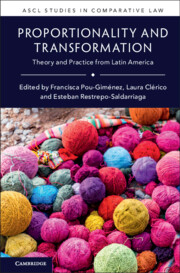Book contents
- Proportionality and Transformation
- Ascl Studies in Comparative Law
- Proportionality and Transformation
- Copyright page
- Contents
- Editors
- Contributors
- Acknowledgments
- Introduction
- Part I Proportionality and Processes of Constitutionalization
- Part II Proportionality in Social Rights and Equality-Based Adjudication
- Part III Proportionality, between Transformation and the Status Quo
- 10 Between Exception and Transition
- 11 Proportionality and State Ius Puniendi
- 12 Distributional Analysis as an Alternative to Proportionality Analysis in Judicial Decision-Making
- 13 Proportionality, Social Justice and Democracy
- 14 Unilateralism, Dialogue and False Necessity
- Epilogue
- Index
12 - Distributional Analysis as an Alternative to Proportionality Analysis in Judicial Decision-Making
from Part III - Proportionality, between Transformation and the Status Quo
Published online by Cambridge University Press: 27 October 2022
- Proportionality and Transformation
- Ascl Studies in Comparative Law
- Proportionality and Transformation
- Copyright page
- Contents
- Editors
- Contributors
- Acknowledgments
- Introduction
- Part I Proportionality and Processes of Constitutionalization
- Part II Proportionality in Social Rights and Equality-Based Adjudication
- Part III Proportionality, between Transformation and the Status Quo
- 10 Between Exception and Transition
- 11 Proportionality and State Ius Puniendi
- 12 Distributional Analysis as an Alternative to Proportionality Analysis in Judicial Decision-Making
- 13 Proportionality, Social Justice and Democracy
- 14 Unilateralism, Dialogue and False Necessity
- Epilogue
- Index
Summary
The chapter discusses distributional analysis as a method of legal analysis interested in understanding the consequences of rules. While recognizing that this method shares this goal with proportionality analysis, the author intimately discards a reconciliation of both based on their different relationship to a theory of democracy. The author argues that proportionality analysis is wed to a vision of judges as restrained by the commands of legislators (or constitutional lawmakers), while distributional analysis sees judges as political actors entrusted with realizing the goal of redistribution. The case of gender mainstreaming is used to illustrate that arguing in favor of the use of distributional analysis does not mean forcing judges into continually adopting structural injunctions, nor provokes such levels of polarization that the sought-after redistribution is sabotaged by increased levels of countermobilization or backlash.
Keywords
- Type
- Chapter
- Information
- Proportionality and TransformationTheory and Practice from Latin America, pp. 265 - 277Publisher: Cambridge University PressPrint publication year: 2022

